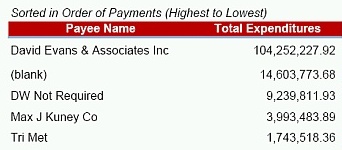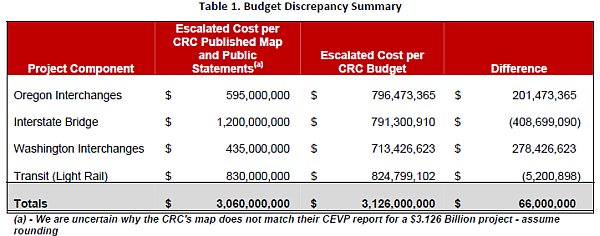 for link to related website
for link to related websiteclick
 for link to source document
for link to source documentclick
 for link to video
for link to video
click  for link to related website
for link to related website
click  for link to source document
for link to source document
click  for link to video
for link to video
Senators, Please Know - Letter for 2014
16 page Stop CRC Report
Stop CRC logo for signs
CRC FACTS: Presented by 1000 Friends of Oregon 
This report includes an overview of the critical interests behind the last several years of planning and project development for the CRC and shows why legislators should vote against the current “Oregon Only” option. 
A New Direction: Our Changing Relationship with Driving and the Implications for America’s Future

The Driving Boom—a six decade-long period of steady increases in per-capita driving in the United States—is over. Americans drive fewer total miles today than we did eight years ago, and fewer per person than we did at the end of Bill Clinton’s first term. The unique combination of conditions that fueled the Driving Boom—from cheap gas prices to the rapid expansion of the workforce during the Baby Boom generation—no longer exists. Meanwhile, a new generation—the Millennials—is demanding a new American Dream less dependent on driving.
Transportation policy in the United States, however, remains stuck in the past. Official forecasts of future vehicle travel continue to assume steady increases in driving, despite the experience of the past decade. Those forecasts are used to justify spending vast sums on new and expanded highways, even as existing roads and bridges are neglected. Elements of a more balanced transportation system—from transit systems to bike lanes—lack crucial investment as powerful interests battle to maintain their piece of a shrinking transportation funding pie.
The time has come for America to hit the “reset” button on transportation policy—replacing the policy infrastructure of the Driving Boom years with a more efficient, flexible and nimble system that is better able to meet the transportation needs of the 21st century.
Acuity Group report 1: Project Sponsors Council and Open Public Meetings Act
A critical report on whether a key group that helped shape the Columbia River Crossing in its early stages violated public meeting laws and deliberately discouraged public involvement.
Acuity Group report 2: Columbia River Crossing – Contracts and Task Order Analysis 
Acuity Group analyzed documents and compiled data over the course of more than 18 months in an attempt to provide clarity related to the expenditures of the Columbia River Crossing project.
Exhibits A-M 

Exhibits N-Z 

Acuity Group report 3: Columbia River Crossing - Ruby Junction and Steel Bridge Costs 

Plans for the $3.5 billion megaproject include upgrades to Portland's Steel Bridge, plus a significant expansion of a TriMet maintenance facility in Gresham. Both would be paid for by the $850 million federal grant that the CRC is banking on to build the light rail extension from Portland to Vancouver.
Acuity Group report 4: Columbia River Crossing - Funding Plan Analysis 

CRC project office continues to mislead both the public and legislators by claiming the total costs of the project to be $3.5 billion. These costs represent solely the costs to construct the project. The CRC project offices current funding plans call for an additional $2.0 billion in debt service costs, toll collection costs, and ongoing operation and maintenance costs; bringing the total cost of the CRC project to approximately $5.5 billion.
Acuity Group report 5: Columbia River Crossing – Sub Contractor Analysis 
Background searches on CRC subcontractors paid more than $250,000 over the course of the project (which began in May 2005) found that several companies were formed between May 2005 and December 2011, indicating that they were not in existence prior to the CRC project’s existence.
Acuity Group report 6: Columbia River Crossing – Cost Allocation Discrepancies 
The result of Couch’s ongoing investigation into the CRC’s expenditure of public funds. This report includes an analysis the project’s detailed budget. The budget indicates costs for Washington and Oregon interchanges are hundreds of millions of dollars more than the amounts being reported to decision makers. The budget also indicates the cost to rebuild the interstate bridge is hundreds of millions of dollars less than the amounts being reported. As a result, it appears that the shifting of interchange costs to the interstate bridge increases the burden of costs to toll payers.
Exhibits A-H 

Cortright's testimony to the Joint Legislative Oversight Committee on Columbia River Crossing:
An in-depth analysis covering seven parts of the financial aspects of the Columbia River Crossing as follows:
1. Traffic forecasts and toll revenues
2. Discretionary federal highway funding
3. FTA new starts transit funding
4. Washington
5. Oregon
6. Cost overruns
7. Likely outcomes
Cortright's CRC Financial Analysis by Impresa, Inc.: 

Independent study by Joseph Cortright, a widely-published leading economic analyst and an expert in regional economic analysis and development. The report raised questions about cost estimation, traffic modeling and financial planning methodologies used for the CRC.
HB2260 "The CRC Blank Check Act of 2013":
“This bill, by itself, gives ODOT essentially unlimited authority to borrow as much as it wants for CRC, and pay bonds back from any combination of toll revenues, future gas tax receipts and federal grants." 
Testimony of Cascade Policy Institute 
The Locally Preferred Alternative in the FEIS, light rail, appears to be spending a minimum of
$855 million to implement a transit option that will increase the current downtown Vancouver to downtown Portland travel time from 16 to 36 minutes.
I-5-Corridor and Columbia River Crossing Review, are there Alternatives to the CRC Project? 
Paul Edgar is one of the many who have a long history with the CRC Process and has attempted to chronicle that history with options and alternatives that could have and should have been considered.
Smart Congestion Relief: Comprehensive Analysis Of Traffic Congestion Costs and Congestion Reduction Benefits
From a Cambridge University Press report “Megaprojects and Risk”:
“As many more and much larger infrastructure projects are being proposed and built around the world, it
is becoming clear that many such projects have strikingly poor performance records in terms of economy,
environment and public support. Cost overruns and lower-than-predicted revenues frequently place project viability at risk and redefine projects that were initially promoted as effective vehicles to economic growth as possible obstacles to such growth.
Edward Merrow in a RAND study of megaprojects:

“Such enormous sums of money ride on the success of mega projects that company balance sheets and even
government balance-of-payments accounts can be affected for years by the outcomes...The success of these
projects is so important to their sponsors that firms and even governments can collapse when they fail.”

April 2013
Dear Senator,
In regards to your upcoming vote on the funding for the Columbia River Crossing (CRC),
PLEASE KNOW: The CRC was created in 2005 to complete a buildable plan in 3 years at a cost of $50M.
Currently in it’s 8th year, it has spent over $170M - That’s a 240% cost overrun. The $170M already spent on design is less than 5% of projected construction costs of a $3.6 billion ($3600M) project.
PAGE 2: As indicated by Congresswoman Jaime Herrera Beutler, this project is full of questionable expenditures and finances.
PAGE 4: The Clark County Commissioners signed a resolution to oppose the CRC.
PAGE 5: The City of Washougal signed a resolution to oppose the CRC.
PAGE 6-7: After the September 2012 elections ten current and newly-elected officials from across Clark County issued a joint statement in the wake of Clark County citizens’ rejection of Proposition 1.
PLEASE KNOW: Our elections have repeatedly shown that light rail and tolls are not supported by SW WA voters. Our one term mayor was elected only by his “no tolls” platform and flipped once he was in office. Tolls will minimally take over $2000 a year from struggling family budgets, between $55M and $85M per year out of the Clark County economy, and strap our community with debt for 45 years.
PAGE 8: The 2009 ODOT "Seismic Vulnerability" report shows that an earthquake scenario of magnitude 9.0 at the Cascadia Subduction Zone resulted in only slight or moderate damage to the Columbia River Interstate Bridge with no extensive damage and no collapse.
PAGE 9: A majority of the existing Columbia River Interstate Bridge was built in 1958. With ongoing preservation the bridge can serve the public for another 60 years.
PAGE 10: A seismic retrofit could be done for a fraction of the cost ($88M to $265M).
PLEASE KNOW: There are 850 "structurally deficient" bridges in Oregon & Washington and the Interstate Bridge is not one of them.
PAGE 11-12: This project is a job killer. The FEIS does not factor in the thousands of long term jobs lost due to the relocation of businesses because of the proposed low bridge plan. The un-approved 116’ height would create the greatest river commerce choke point for 190 miles between the Pacific Ocean and The Dalles.
PAGE 13: The downtown business community in Vancouver would be crushed by 6.3 years of choking
construction and suffer from a loss of access to I-5 and Highway 14.
PAGE 14: Telecommuting grew nationally by 73% between 2005 and 2011. Telecommuters now outnumber transit riders in the Portland metropolitan area - All with virtually no public investment.
PAGE 15: Over 90% of I-5 bridge lifts could be eliminated by the “Vancouver BNSF Rail Bridge Project.”
PAGE 16: Ask highway builders how to fix traffic problems and they will always answer with more highways.
PLEASE KNOW: The fundamental flaw with this project is that the root of our traffic problems in Clark County is not a bridge, a lack of lanes, or a lack of transit - It is due to a lack of local jobs in SW Washington. It is completely counterproductive to invest in a project that destroys or chases out the good long term jobs we have already built here. Treat the cause, not the symptom.
Thank you for your efforts and your service as an elected official.
Please support the will of the voters and stop all funding for the CRC.